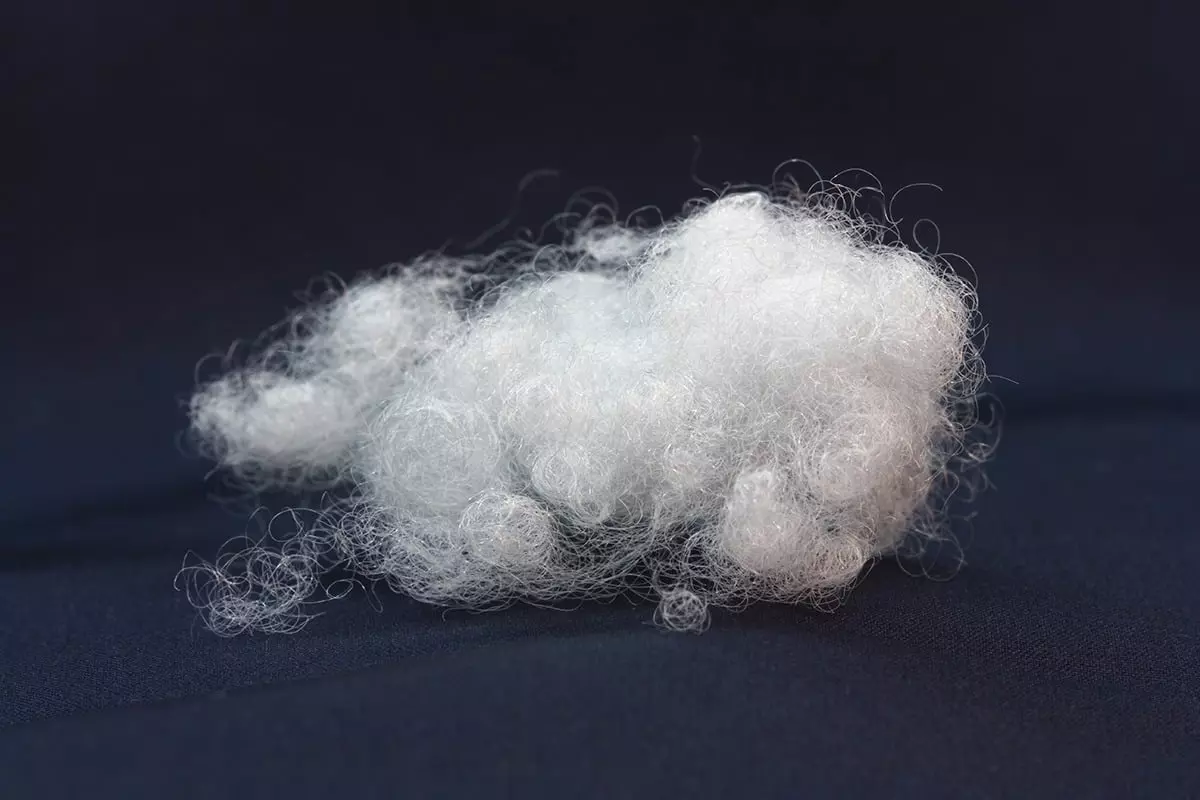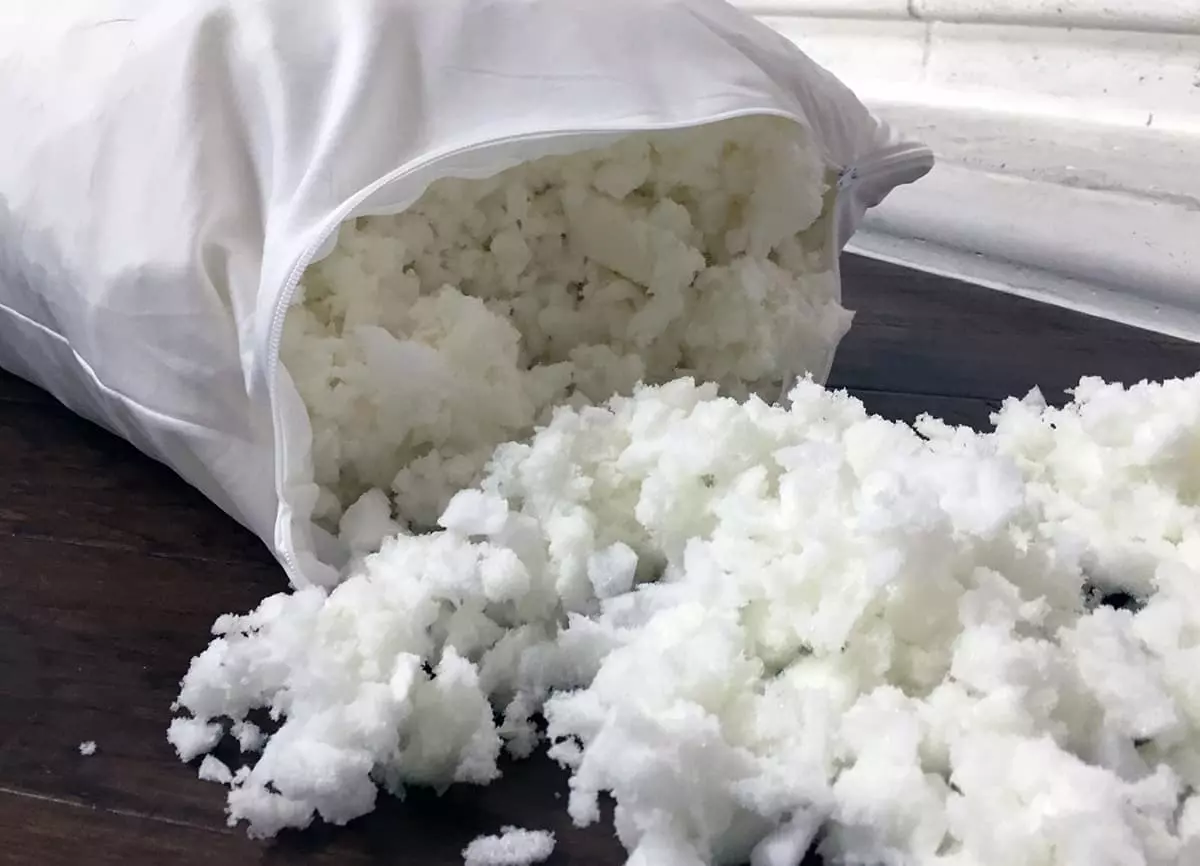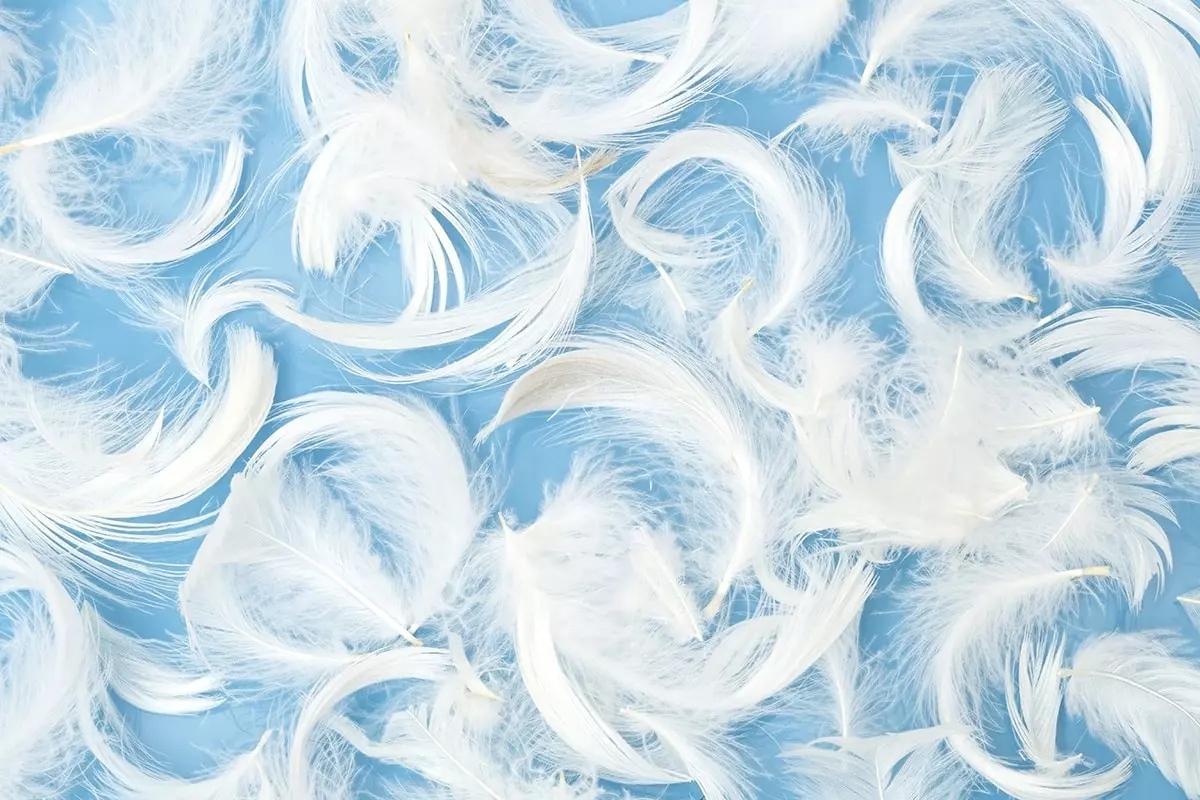Along with a comfortable mattress, pillows are an integral part of a good night's sleep. Which means that when you find a pillow that feels good, you tend to stick with it, right? Not so fast. Pillows have become more diverse and innovative than ever before. It may be time to put down that old down pillow and pick up one made with a unique filling like buckwheat hulls, kapok fibers, or even gel.
So, if you're looking to change things up in the bedroom - we're still talking about pillows, here - we've put together 15 different types of pillows and what you should know about each so that you can find the best pillow for you.
15 Types of Pillows
- Down Pillows
- Down Alternative (Synthetic) Pillows
- Memory Foam Pillows
- Shredded Foam Pillows
- Latex Pillows
- Body Pillows
- Adjustable Pillows
- Feather Pillows
- Buckwheat Pillows
- Kapok Fiber Pillows
- Water Pillows
- Gel Pillows
- Microbead Pillows
- Cotton Pillows
- Wool Pillows
 Caption: Down pillow filling
Caption: Down pillow filling
Down
Down is a soft grouping of fibers that lay closest to a bird's skin and are located primarily near its chest. Down usually comes from a goose, duck, or swan and higher quality down is commonly called European White Goose down or Hungarian Goose down. Clusters of down fan out from a central point and create a 3D effect, giving the cluster an insulating quality. Many down pillows are also filled with feathers.
Pros:
- Lightweight, soft, and natural
- Cushiony over firm - good for stomach sleepers
- Insulating and they tend to last longer than synthetic alternatives
Cons:
- Some allergies are associated with down and can be on the pricier side
- May be difficult to clean and needs fluffing to keep loft
Down Alternative (Synthetic)
Just like its name, down alternative pillows are made with a synthetic filling - most likely puffs of polyester - that is intended to mimic true down pillows. They can be good for those with down allergies as they are hypoallergenic. They're also more likely to be cheaper than down pillows.
Pros:
- Good for a tighter budget, typically easy to care for
- Still soft and lightweight, as well as hypoallergenic
- Easier to care for than down pillows
Cons:
- Hard to duplicate the insulation (warmth) compared to down
Memory Foam
Memory Foam pillows are made using polyurethane and are also sometimes called visco-elastic. They contour to the shape of your head and neck while you sleep, providing excellent support and alignment. Memory foam pillows are popular for their density and responsiveness.
Pros:
- Good support for pain relief or to assist with other sleep and health issues
- No lumping and can be made into a variety of shapes and sizes
- Contouring to head and neck, and very durable
Cons:
- Off-gassing potential
- May be too firm for stomach sleepers
Shredded Memory Foam
 Caption: Coop Home Goods Adjustable Shredded Memory Foam Pillow Review
Caption: Coop Home Goods Adjustable Shredded Memory Foam Pillow Review
Shredded memory foam pillows are an innovative version of memory foam pillows. The shredded pieces of foam create a more adjustable and flexible feel but with a similar bounce and responsiveness as the memory foam pillow.
Pros:
- Firmer/Good for back and side sleepers
- Moldable and supportive
- Easier to clean than down
Cons:
- Off-gassing potential
- May flatten out over time and require fluffing
- May be too firm/overstuffed and often take a long time to fully dry
Latex
Latex pillows are made from the sap of a rubber tree called the Hevea-Brasiliensis tree. They offer softness and support and are known for their durability. Latex pillows are increasingly popular for their long-lasting qualities.
Pros:
- Soft, supportive, and durable
- Natural Latex pillows will keep their shape and responsiveness but will eventually biodegrade
Cons:
- Can be blended with polyurethane foam and lose durability
- Bad for those with latex allergies and heavier compared to other options
- Lacks breathability
Body Pillow
 Caption: 14 Types Of Pillows You Should Know About
Caption: 14 Types Of Pillows You Should Know About
Body pillows are long and narrow pillows that support your entire body. They are typically used for comfort, support, or pressure relief. Body pillows are popular with pregnant women or people recovering from injuries who need extra support below their head.
Pros:
- Can help ease specific aches and pains
- Good for expectant mothers and versatile
- Can be made with organic or conventional materials
Cons:
- Tend to be large/take up significant space on the bed
- Can create separation between you and your sleep partner
- Pillowcases can be tricky to get on and off for cleaning
Adjustable
 Caption: Adjustable pillow filling
Caption: Adjustable pillow filling
Adjustable pillows can be made with all types of filling, with the common denominator being the ability to add or remove the filling to your desired lift and firmness. This option is popular with shredded memory foam pillows or other pillows with easily-removable filling.
Pros:
- Good for any type of sleep position and comes in a variety of fillings, shapes, and sizes
Cons:
- Messy and the pillow filling needs to be removed hygienically for optimal use
- Can take a little time to find the right amount of loft; some experimenting may be needed
Feather
 Caption: 15 Types Of Pillows You Should Know About
Caption: 15 Types Of Pillows You Should Know About
Feather pillows are filled with feathers from the wing and back feathers of geese or ducks. They provide a soft and fluffy feeling but retain their shape longer than down pillows. Feather pillows are larger and more structured than down clusters.
Pros:
- Soft, lightweight, and holds shape
- Firmer/more structure
Cons:
- May sleep hot and flatten easily - needs fluffing
- Allergies may be an issue for some and quills may poke out and cause irritation
Buckwheat
 Caption: 14 Types Of Pillows You Should Know About
Caption: 14 Types Of Pillows You Should Know About
Buckwheat pillows are filled with buckwheat hulls, which are the hard outer shell that protects the buckwheat seed. They are breathable, hypoallergenic, and conform to the head and neck to help keep the spine aligned.
Pros:
- Hypoallergenic and allows for air movement
- Natural, supportive, and moldable
Cons:
- The hulls make noise when they rub against each other
- May be too firm for stomach sleepers
- Heavier than other options and the pillow will have a "crunchy" feel
Kapok Fiber
 Caption: Kapok fiber pillows
Caption: Kapok fiber pillows
Kapok fibers are the seed pod fluff of a rainforest tree called the Ceiba tree. The fibers are naturally buoyant and often used as a natural bedding filling. Kapok fiber pillows are soft, lightweight, and they'll need to be fluffed on occasion.
Pros:
- Soft, lightweight, and buoyant
- Creates loft and is hypoallergenic
- Naturally mold and mildew resistant
- Eco-friendly (naturally biodegradable)
Cons:
- Needs to be fluffed
- Inflammable (if it catches on fire it will be difficult to put out)
- Labor-intensive to harvest and may be more expensive
Water
 Caption: Drop of water resembling the fill of a Water Pillow
Caption: Drop of water resembling the fill of a Water Pillow
Water pillows are filled with water and maintain their consistency no matter what pressure is applied to them. They conform to your neck and head and require no fluffing.
Pros:
- Anchored to where you are and won't move around
- Conforms to your neck and head and no fluffing involved
- Can be adjustable if you add/remove water, and also hypoallergenic
Cons:
- Leaks will cause trouble and potentially ruin your mattress
- May be potentially too firm for stomach sleepers
Gel
 Caption: 15 Types Of Pillows You Should Know About
Caption: 15 Types Of Pillows You Should Know About
Gel pillows are filled with gel and help keep the pillow cool, consistent, and firm. They can be combined with other fillings like memory foam for additional comfort.
Pros:
- Do not require shaking or fluffing and easy to care for
- Cool sleeping surface, pressure relieving, and hypoallergenic
- Can be combined with other fillings like memory foam
Cons:
- May not be a good fit for all sleepers
- You will not "sink" into the pillow like you would a traditional down pillow
Microbead
 Caption: The Ostrich Pillow Travel Pillow Review
Caption: The Ostrich Pillow Travel Pillow Review
Microbead pillows are made up of many polystyrene beads that offer support and flexibility. They allow for excellent airflow and breathability.
Pros:
- Supportive and moldable (you can shift beads to meet your needs)
- Allows for excellent airflow and breathability
Cons:
- Size of the microbeads may vary and not the most eco-friendly option
- Messy if microbeads escape from their covering
Cotton
 Caption: Cotton pillows source
Caption: Cotton pillows source
Cotton pillows are stuffed with cotton or covered in an outer cotton fabric. They offer natural absorbency and hypoallergenic properties but may flatten out or get lumpy over time.
Pros:
- Natural and generally hypoallergenic
- Breathable (naturally absorbent)
Cons:
- Needs to be cleaned regularly to avoid dust mites and mold
- May flatten out or get lumpy over time
- Does not contour to the head and neck easily
Wool
 Caption: Wool pillows sheep
Caption: Wool pillows sheep
Wool pillows are made from the wool of sheep and offer softness and natural temperature regulation. They help regulate body temperature and are naturally antimicrobial and antibacterial.
Pros:
- Helps regulate body temperature and is eco-friendly (renewable resource)
- Naturally anti-microbial and anti-bacterial
- Natural fire retardant and dust mite resistant
Cons:
- Absorbs odors and needs special care - dry clean only
Remember, finding the right pillow is important for a good night's sleep. Consider your sleeping position, preferences, and any specific health concerns when choosing the perfect pillow for you. Sweet dreams!

















